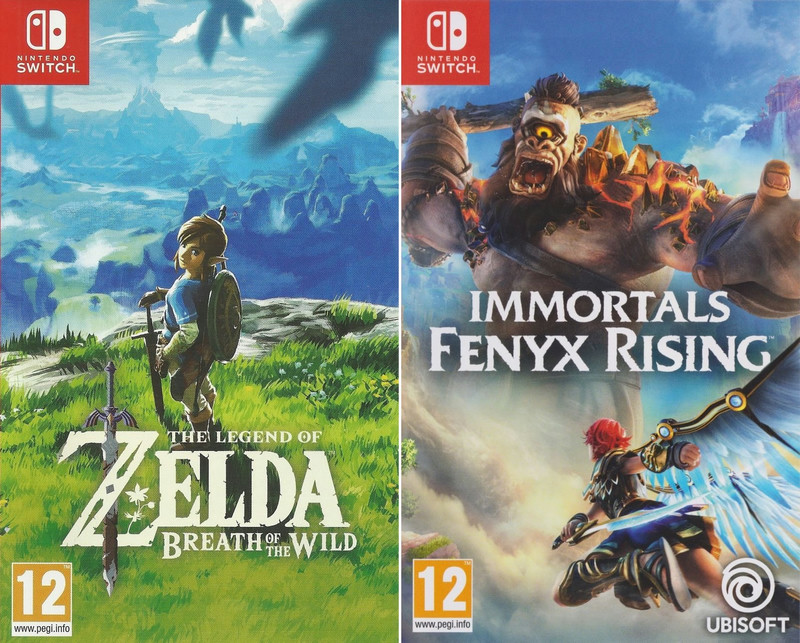Comparing the cover art of Immortals Fenyx Rising and The Legend of Zelda: Breath of the Wild
Videogames
How Ubisoft’s new game can’t possibly live up to the Nintendo classic it tries to emulate
In a dreary neighbourhood of the Japanese city of Kyoto sits the Nintendo Development Centre, a squat seven-storey building surrounded by a forbidding security wall. If it weren’t for the large company logo on the side, the building could comfortably pass for a mildly-fortified US embassy.
The journalist Simon Parkin has called it a ‘Willy Wonka-esque factory’ for, despite its dull and unassuming facade, imagination runs wild inside the building. It was here that 2017’s The Legend of Zelda: Breath of the Wild was developed. Generally considered a masterpiece — ‘unerringly magical’ (Edge magazine), ‘a total marvel’ (Eurogamer), ‘uniformly stunning’ (Polygon) — the game shunned a structured storyline and formulaic gameplay and replaced it with liberating exploration that rewarded experimentation and curiosity. For the first time in a video game, I found myself wandering around and soaking up the game, travelling not to go anywhere but simply to go. What a delight to fall prey to your wanderlust and climb a high mountain peak, follow a path, catch wild horses. It’s a cliche, but my second attempt to play the game to completion was more enjoyable than the first.
Success is inevitably followed by imitation. Other companies want what Nintendo has. Immortals Fenyx Rising1, from French games giant Ubisoft, is one of the most shameless knock-offs, attempting to merge the company’s successful Assassin’s Creed series with the magic of Zelda. Reviews suggest it’s good but not great, not quite hitting the highs of Breath of the Wild. Whereas Nintendo’s title scores 97% according to Metacritic, a review aggregator, Immortals scores 76%. Good, but not great.
Still, I’ve spent more than one hundred hours playing Breath of the Wild, and with the promised sequel still months — if not years — away, the idea of a new, similar, game piqued my interest. For those of us craving more Zelda, good might be good enough. And, of course, I’m curious to see how well they’ve imitated Nintendo’s classic. I’ve yet to play it, but I will early in the new year.
Even without playing it, comparisons can be made. The most glaring, to me, is the cover art of the two games. It’s an immediate indication that Immortals can only fail to live up to Breath of the Wild.

The European cover art for Nintendo’s The Legend of Zelda: Breath of the Wild and Ubisoft’s Immortals Fenyx Rising. Where Breath of the Wild highlights an open landscape ready to be discovered, Immortals can’t bring itself to promise the same and instead falls back on ‘Look, there’s fighting!’
Cover art — be it for a book, a film, a video game — is a signal for what to expect inside. And what does Breath of the Wild signal to us? I think my favourite touch is the out-of-focus leaf in the top-right corner. What a beautiful thing this is: it brings you, the player, into the scene. Without it you’re static, looking at something but not part of it. With it, you’re in the scene, coming out of the undergrowth to stand next to Link. And Link is looking flirtatiously over his shoulder at you. In front of him lies the open landscape of Hyrule, with the looming danger of a smoking volcano in the distance. His look says, ‘This is for us to explore together. Are you ready?’
And the Immortals box art? There is no subtlety, it simply throws you midway into a battle and screams ‘MONSTERS! FIGHTING!’ And therein, it seems, lies the difference between the two games: Breath of the Wild is about exploration, Immortals is about fighting. One is delicate and understated, the other is raw and unsophisticated. As Yahtzee Crowshaw said in a typically caustic review:
Remember how in [Breath of the Wild] we’d stand on lookout towers and find places to go to by looking for them with our eyeballs like how looking for things in reality works? Well, [Immortals] doesn’t have the sterling visual design to pull that off, so instead you have to systematically move your cursor over a load of seemingly empty landscape, waiting for the little sensor to go ‘Widdly-wee’, at which point another icon gets added to the map like a cornflake in the beard of an ill-fated first date. And there are so many fucking icons to find from any given location that the process is incredibly tedious.
I think I know which one I’m going to like best.
I presume the game’s title is a nod to the phoenix of Ancient Greek myth, but why spell it ‘fenyx’? There’s an archaic form of the word, ‘phenix’, and there’s the Old English ‘fenix’, but ‘fenyx’ seems to have just been made up for the game. It comes across as fairly silly and immature. It’s hard to convince my wife that games are something other than toys for teenage boys, and names like this make it impossible. Why, developers, why?!